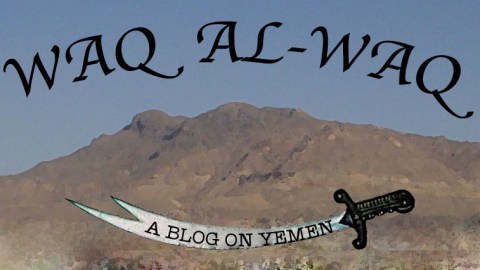A Bloody Anniversary in Yemen

Six months after the bloodiest day in Yemen’s uprising, forces loyal to President Ali Abdullah Salih were at it again.
That time, six months ago on March 18, snipers loyal to President Salih opened fire on unarmed protesters in the Square of Change in Sanaa shortly after Friday prayers, killing 52 in minutes of sustained fire.
This time, on Sunday September 18:
“antigovernment demonstrators tried to march for the first time in months beyond the part of Sana where they have camped in a sit-in under the protection of General Ahmar. As they did, men in civilian clothes opened fire from rooftops, the protesters said, and government security forces shot at them from a Ministry of Electricity building and, using machine guns, from the backs of pickup trucks. The gunfire lasted about an hour.”
That description is from Laura Kasinof’s fine piece in the NY Times, one of the few English-language reporters (along with Jeb Boone, Iona Craig, and Tom Finn) to really focus on Yemen.
With the fighting ongoing today, the casualty figures of more than 20 are likely to rise.
The brutal crackdown has spawned a great deal of hand-wringing from outside observers.
Today, Marc Lynch of Foreign Policy, whose work I respect, has an article on “The Costs of Ignoring Yemen,” in which he claims: “the violent crisis which many of us have been warning would result from neglecting Yemen and allowing its political stalemate to grind on has now arrived.”
Well, the crisis may have arrived, but that is about as far as I can go towards agreeing with Lynch.
The gist of his piece is that analysts have been warning that if the US didn’t do something quick in Yemen to solve the political crisis very bad things were going to result, but instead of listening to the analysts the US ignored Yemen.
I don’t think that is quite true.
A few, I would say very few analysts have been warning about this – but most of the analysts whose names one reads in the newspapers or sees on television are merry-go-round commentators, speaking on Libya one week, dissecting Syria the next, and then explaining Yemen when something goes boom in Sanaa.
The newspapers have ignored Yemen – this is what newspapers do. It is tough to write – let alone get people to read – a story about the inner-workings and behind-the-scenes political calculations of diverse and opaque groupings in Yemen. Particularly when few have an intimate knowledge of the primary players.
And because the news media, as should be expected, largely ignored Yemen when there were bloodier crises to cover in Libya and Syria and as a result so did the merry-go round experts in DC and Europe.
But the US did not.
Now I completely disagree with the way the US has approached the crisis in Yemen since the uprising started in February, and I think my record is pretty clear on that, but I can’t say it has ignored Yemen.
In fact, only a couple of weeks ago, John Brennan, who has emerged as the US point man on Yemen – which should tell you something about US priorities in Yemen, given that he is a counterterrorism adviser – explained that Yemen’s cooperation with the US was better than ever since Salih left the country.
It took me some time to work what exactly Brennan and these US officials meant, but I think I now have a pretty good idea. Without getting into too many names and details I think it is fair to say that this increased cooperation against AQAP makes it harder for the US to completely transition away from President Salih and his immediate family.
Again, I believe this is a mistake – and as I’ve said numerous times in the past, the US won’t see real gains against AQAP until it deals with the political problem in Yemen. There is an order to these problems – and the US is approaching it backwards, which not only prolongs the crisis in Yemen, but puts long-term US national security interests at risk.
Some analysts see what is happening in Yemen as a elite struggle for power – largely confined to the Hashid tribal confederation. And they are right, that is taking place.
But that is only one part of the story.
In Sanaa and centered around the capital there is a play for the state by Salih’s immediate relatives led by his eldest son Ahmad, defected soldiers loyal to Ali Muhsin al-Ahmar, and the other Bayt al-Ahmar led by Sadiq and his younger brother Hamid.
On the periphery of the state something else is happening. Other actors are busy gobbling up as much territory as they can hold in an effort to gain autonomy and power while the elites fight over the carcass of the state.
In the north, the Huthis are solidifying control over territory they have held. In the south Islamic militants, some linked to AQAP, continue to try to hold towns and territory despite air attacks. And there are increasing rumblings from the south that the time may be drawing near to once again break away from the north and its crazy succession of tribesmen.
So what we have in Yemen, is a steadily shrinking center (the traditional state) that the Hashid elites are fighting over on the backs of the protesters, while on the periphery groups that feel they haven’t gotten a fair shake in decades, now believe the time is right for them to push forward and try to take as much as they can hold.
This, needless to say, is a disaster and one that is likely to get worse before it gets better.
I’m not really sure how the US State Department didn’t see this violence coming, when it announced its hopes that there would be a transition in a week. With so many dead bodies in Sanaa and around the country jokes are inappropriate, but it is baffling to me that the State Department wasn’t more cautious – and didn’t see that violence in Yemen often lurks right around the corner from a magnanimous offer.





